This first table shows the CE 280’s Watts/10 Delta Temp numbers in a quick glance chart format.

Using this data we can effectively show percentage gains/losses relative to a reference point. It’s an interesting way to show gains/losses while changing a variable.
So, let’s focus on 1300 RPM as our reference and see how much gain or loss in performance we get by changing fan speed.

From these results we see a ~35% drop in performance of from 1300rpm to 750 in both Push Only and Push/Pull. The increase of ~25% with the next fan speed increase is similar to those gained by the slim radiators of the test group. This indicates the CE 280 is likely best tuned for low or medium speed fans as the extra air volume of higher rpm are not as much benefit as it is on radiators with thicker cores.
So from the data above we’re getting a good idea of how the CE 280 radiator performs relative to itself. But there is a large selection of 280mm radiator models to choose from, so let’s put the CE 280’s results into some comparison charts.
Push Only Data vs Competition
In general, thicker radiator perform better than thinner radiators of the same size (fan capacity) but a lot also has to do with how each core has been designed / tuned; number of tubes, thickness of tubes, fin array etc.
So with that in mind, we should try to stay focused on radiators with similar dimensions when comparing.
If you only have space for a 45mm (or less) thick radiator, there is no point in you analyzing the data for thicker models also, although comparisons are interesting.
The XT45 is the same thickness as the CE 280, but don’t rule out a few of the slim models also.
Focusing on the Push Only results for now, let’s see how the CE 280’s performance compares to the competition.
Let’s start with 750 RPM.
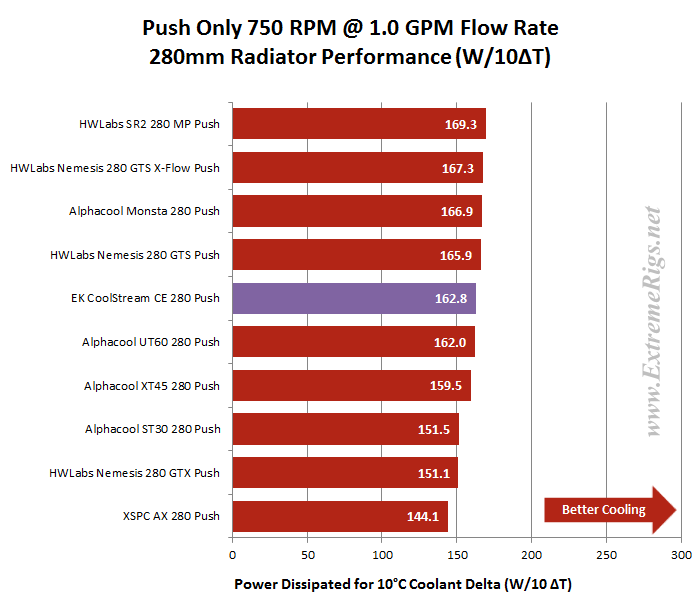 The CE 280 has placed 5th in Push Only at 750 RPM. Finishing just ~4% behind the winning rad and ahead of some radiators which are 25% thicker, this is a great result for the CE280.
The CE 280 has placed 5th in Push Only at 750 RPM. Finishing just ~4% behind the winning rad and ahead of some radiators which are 25% thicker, this is a great result for the CE280.
Now let’s look at 1300 rpm:
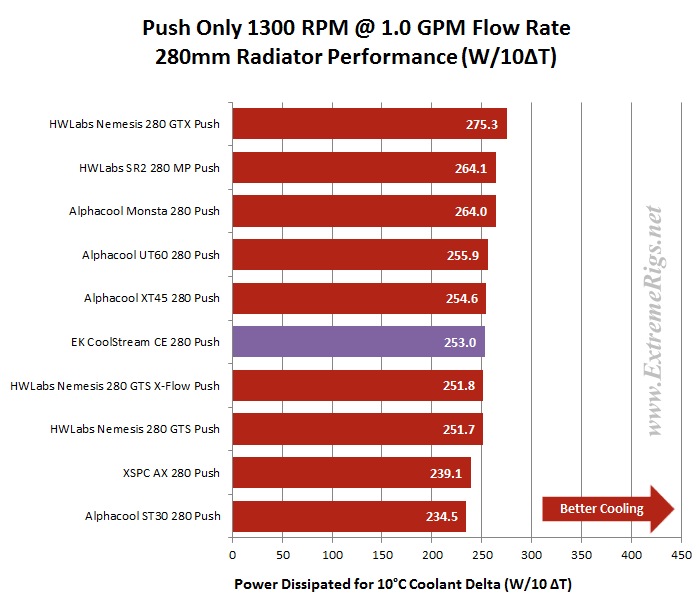 At Push Only 1300 RPM the CE 280 drops one position to finish in 6th place. The difference between it and the other 45mm thick radiator is less than 1%, so there is no clear winner at this data point.
At Push Only 1300 RPM the CE 280 drops one position to finish in 6th place. The difference between it and the other 45mm thick radiator is less than 1%, so there is no clear winner at this data point.
Now 1850 rpm Push Only:
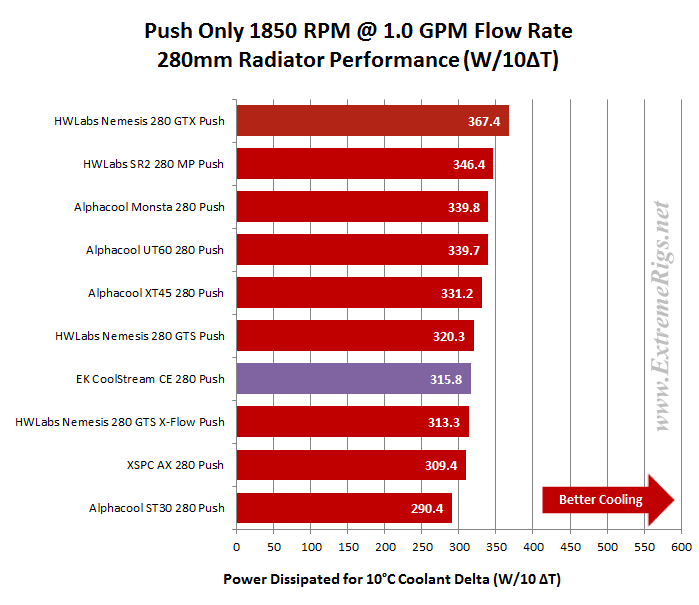 At 1850 rpm the CE 280 loses another position in the rankings and has been overtaken by one of the slim radiators. I think we can safely say the possible bias towards fan speeds mentioned earlier is for low to medium rpm fans. That’s not a bad thing though, as not everyone is willing to tolerate the noise of 1850+ rpm fans for the potential performance gains. Quite the opposite even, we suspect that most users would prefer radiators that perform best with low to medium speed fans.
At 1850 rpm the CE 280 loses another position in the rankings and has been overtaken by one of the slim radiators. I think we can safely say the possible bias towards fan speeds mentioned earlier is for low to medium rpm fans. That’s not a bad thing though, as not everyone is willing to tolerate the noise of 1850+ rpm fans for the potential performance gains. Quite the opposite even, we suspect that most users would prefer radiators that perform best with low to medium speed fans.
Let’s find out how the CE 280 performs with Push/Pull fans.
Push/Pull Data vs. Competition
Firstly the 750 rpm:
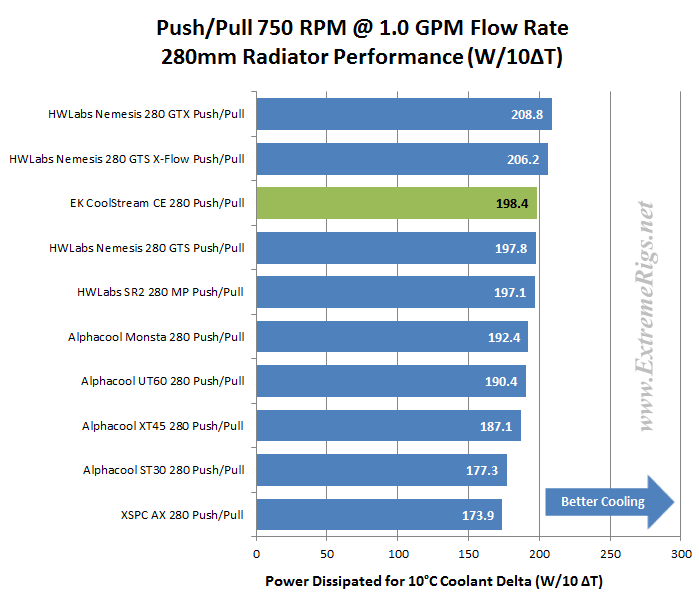 Bingo! If that’s not a sweet spot then I don’t know what is. The CE 280 placed 3rd and was about 5% behind the 54mm thick GTX which in case you hadn’t noticed has made a habit of taking top spot. Of more relevance is it finished ~6% ahead of the other 45mm thick radiator. Two slim radiators performed exceptionally well at this data point, one of them even finishing ahead of the CE 280.
Bingo! If that’s not a sweet spot then I don’t know what is. The CE 280 placed 3rd and was about 5% behind the 54mm thick GTX which in case you hadn’t noticed has made a habit of taking top spot. Of more relevance is it finished ~6% ahead of the other 45mm thick radiator. Two slim radiators performed exceptionally well at this data point, one of them even finishing ahead of the CE 280.
Let’s move to 1300 rpm:
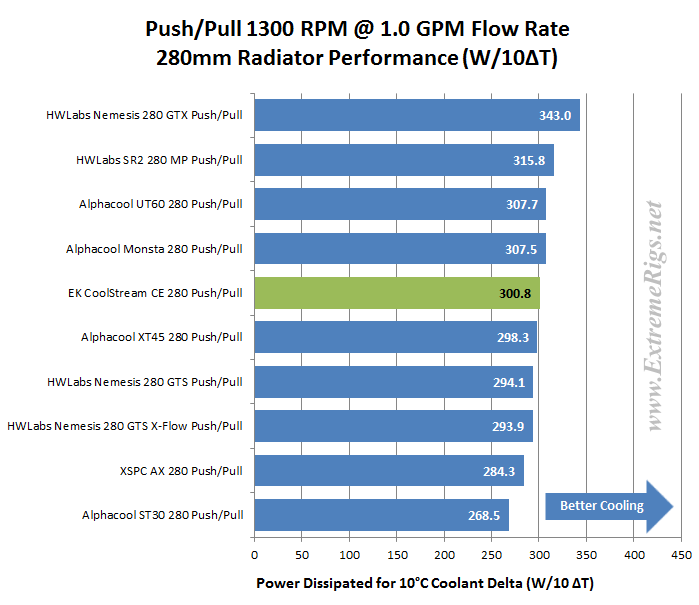 At 1300 rpm Push/Pull the thicker radiators move into the top half of the rankings as their thicker cores are able to utilize the extra air flow. The CE 280 takes a respectable 5th place just ahead of the other 45mm thick contender.
At 1300 rpm Push/Pull the thicker radiators move into the top half of the rankings as their thicker cores are able to utilize the extra air flow. The CE 280 takes a respectable 5th place just ahead of the other 45mm thick contender.
Now 1850 rpm:
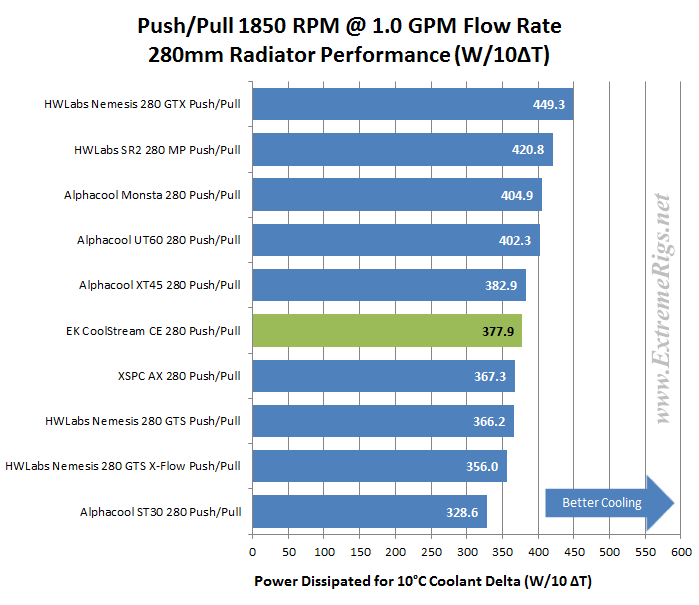 At 1850 rpm the CE 280 which does seem to have a bias slightly against high speed fans drops a ranking position but is just 1.5% behind it’s rival, the XT45.
At 1850 rpm the CE 280 which does seem to have a bias slightly against high speed fans drops a ranking position but is just 1.5% behind it’s rival, the XT45.
Let’s now combine the Push Only and Push/Pull results of our 1.0 GPM flow rate tests. Sometimes these combined plots show up points of interest, but in this case the combined plots did not show anything up which was out of the ordinary or amazing, so I have decided to “spoiler” them. This way readers who like these plots can still see the data.
Another view of the same data, this time plotted as curves and some extrapolation added.
Be warned these plots can be hard to read given that many results are similar at the same data points.
Again the Push Only data first:
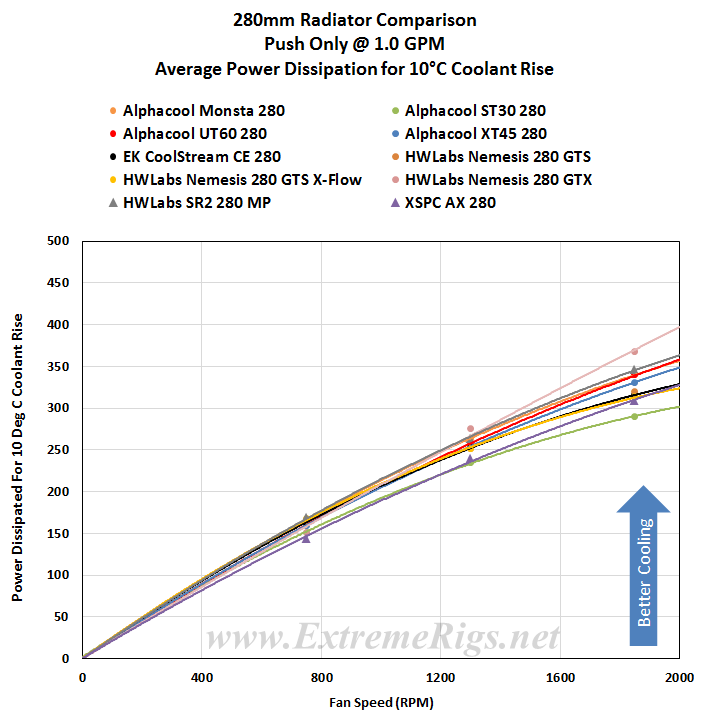 This perhaps best shows just how close the results are, particularly with low speed fans.
This perhaps best shows just how close the results are, particularly with low speed fans.
Because the data curves in plot above are almost blurred into one another, we have split it into two separate plots; 750 rpm to 1300 rpm and 1300 rpm to 1850rpm and zoomed in on those fan speed zones.
Now the Push/Pull results are plotted, again followed by split and zoomed versions.
In the following plots the heat dissipation results for the three CE series radiators we have tested have been put together for a comparison. They are “just for fun” plots which some readers may benefit from.
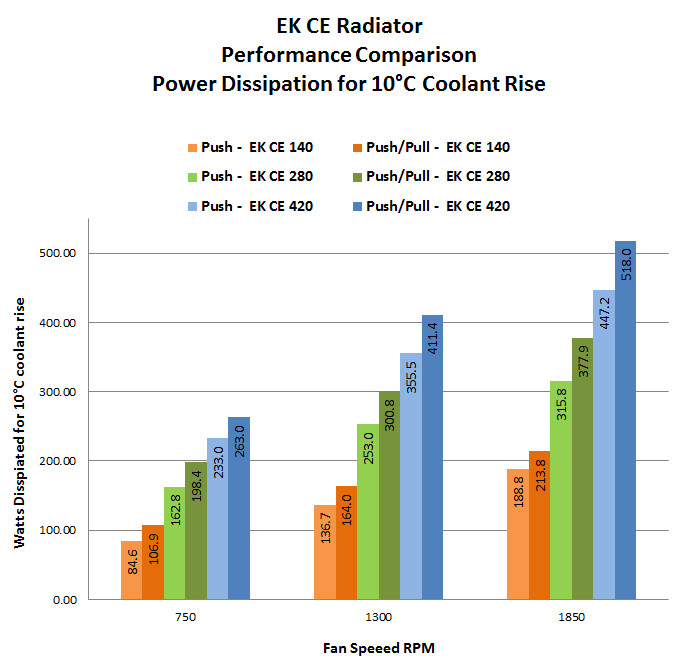 Sorry in the next plot below the color codes don’t match the plot above. This is the same data with extrapolation added.
Sorry in the next plot below the color codes don’t match the plot above. This is the same data with extrapolation added.
From all the test results we created “Average Performance Factor” charts for both Push Only and Push/Pull. We then made a combined plot of the average called the “Master Performance Factor”. The radiator with the best cooling ability (W/10ΔT) at each rpm was awarded a score of 100. Each other radiators W/10ΔT result was scored as percentage of the top performer.
This way of looking at the comparison takes away any advantages that a radiator may have at higher or lower fan speeds and looks at an overall average. While this appears fair it does tend to favor those radiators that are all-rounders and those radiators which do very well at high RPM. Most users should be more focused on their specific use case.
Here are the CE 280’s percentage scores at each data point:
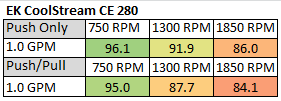 This table shows us that the CE 280 is on average ~10% behind the best performing radiator at each data point that was tested. The results “appear” to get worse with increased fan speeds, but that does not mean that the CE 280’s performance got worse (although we do believe it has a bias for low to medium speed fans), more so that the best radiator got better as the fan speeds increased.
This table shows us that the CE 280 is on average ~10% behind the best performing radiator at each data point that was tested. The results “appear” to get worse with increased fan speeds, but that does not mean that the CE 280’s performance got worse (although we do believe it has a bias for low to medium speed fans), more so that the best radiator got better as the fan speeds increased.
As these percentage scores are relative to the best performer at each data point, we again advise readers to cross reference specifications and results for each radiator and keep in mind your intended fan assembly and operating speed.
The percentage numbers in the table above offer another way of looking at the CE 280’s results. But for our scoring system we need a way to reduce the categories while retaining the data. To do this we average the results for each fan assembly type giving us Averaged Performance Factors. We calculate this for Push Only, Push/Pull and finally an average of everything.
Firstly – the Push Only APF:
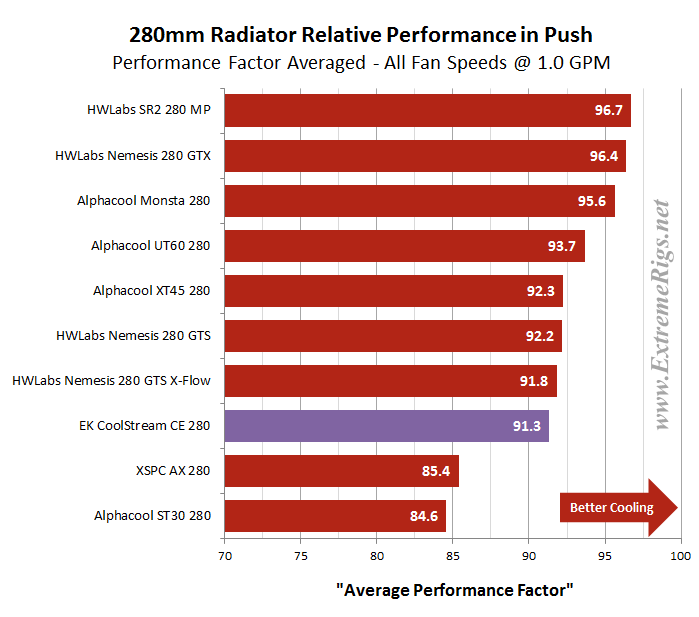 With an 91.3 % Averaged Push Only result the CE 280 places 3rd last in the rankings. BUT with just 1% variance between 5th and 8th position, it has to be called a 4 way tie for 5th place after test error margins are factored in.
With an 91.3 % Averaged Push Only result the CE 280 places 3rd last in the rankings. BUT with just 1% variance between 5th and 8th position, it has to be called a 4 way tie for 5th place after test error margins are factored in.
Now the Push/Pull APF:
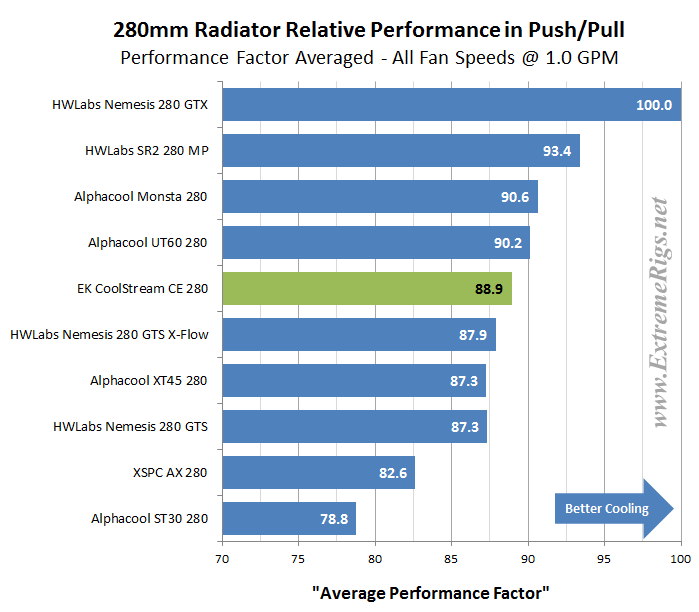 In the Push/Pull APF the competition is again close in the middle of the pack, but being ahead by a “whole” 1% we are prepared to give the CE 280 5th position outright. Only thicker radiators are ahead of it (which seems logical) and it finishes ahead of it’s direct rival.
In the Push/Pull APF the competition is again close in the middle of the pack, but being ahead by a “whole” 1% we are prepared to give the CE 280 5th position outright. Only thicker radiators are ahead of it (which seems logical) and it finishes ahead of it’s direct rival.
Finally we created the Master Performance Factor which is calculated from the averaged results of all the Push Only and Push/Pull thermal tests, at all fan speeds.
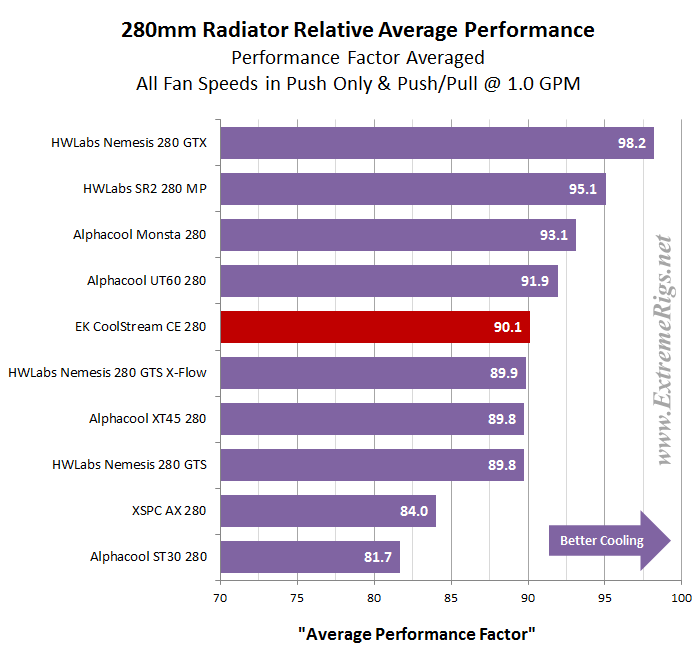 The overall thermal performance results in the middle of the group are extremely close! Based on data only the CE does place outright 5th, but we have to factor in test error margin of the equipment and so that means it is in a 4 way tie for 5th position. Note also that by sneaking over 90 the mark the CE 280 will score higher in our auto generated summary scoring calculations than it’s rival XT45.
The overall thermal performance results in the middle of the group are extremely close! Based on data only the CE does place outright 5th, but we have to factor in test error margin of the equipment and so that means it is in a 4 way tie for 5th position. Note also that by sneaking over 90 the mark the CE 280 will score higher in our auto generated summary scoring calculations than it’s rival XT45.
Space Efficiency
The CE 280’s space efficiency vs. performance ranking is likely to be neither good or bad (hopefully) as it’s 45mm thickness is very middle of the road. Thinner rads almost always produce better results in this metric than their thicker counterparts. We have used the Average Performance Factor results from the charts above to compile two plots which shows us how it compares to the other rads in terms of performance Vs. space taken.
First up is Radiator Thickness Vs. APF
Here the combined APF scores were divided by the radiator thickness only, with the highest (most space efficient) issued a score of 100. Each of the other radiators results was converted to a percentage of the most space efficient radiator’s score.
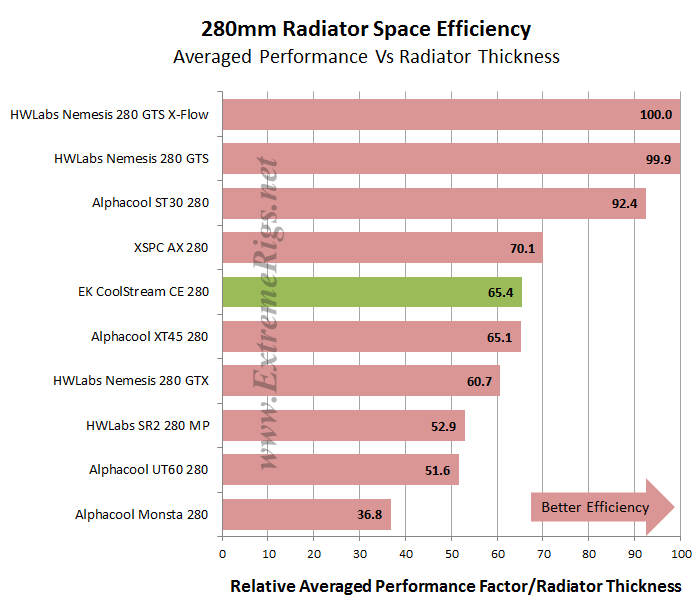 The order has ended almost in order of thinnest to thickest. The results of the two 45mm thick radiators of the test group are very close indeed.
The order has ended almost in order of thinnest to thickest. The results of the two 45mm thick radiators of the test group are very close indeed.
Next we took the APF results for Push/Pull and divided it by the total thickness including the fans and applied the same scoring system. For the Push Only we used the Push Only Vs Push/Pull comparative results and applied the same scoring system when compared against the Push/Pull.
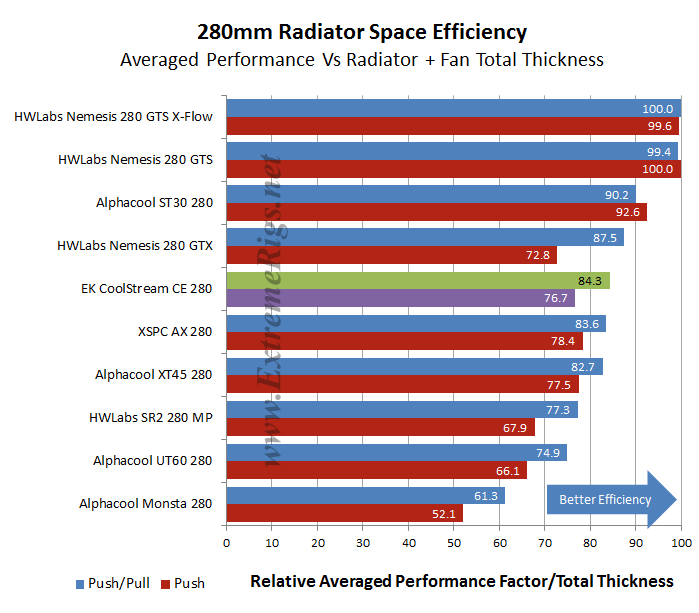 This plot is likely the most useful for readers of the 2 plots for space efficiency. With fan thickness factored in the CE 280 finishes roughly in the same position for Push Only and Push/Pull, while those around it jostle for position.
This plot is likely the most useful for readers of the 2 plots for space efficiency. With fan thickness factored in the CE 280 finishes roughly in the same position for Push Only and Push/Pull, while those around it jostle for position.
Value Factor
While our APF’s are still fresh in mind, let’s now look at some results vs Price to show which of the 280mm radiators might offer the best bang for your buck. Each radiator’s combined APF scores were divided by the radiator cost and again we applied our scoring system of percentage Vs. the best performer of the category.
The CE 280’s Value Factor turns out to be very good, which tells us that it’s $76 USD price is great value for the performance potential it offers. In reality the differences are not great, but when visualizing with percentages as we have done, the gap appears large.
Generally value and space efficiency metrics usually correlate – thicker radiators do contain more material afterall and so are usually also more expensive. Therefore the CE 280 finishing higher in the Value metric than Space Efficiency most likely means it offers excellent bang for your buck.
Next Up – Summary!








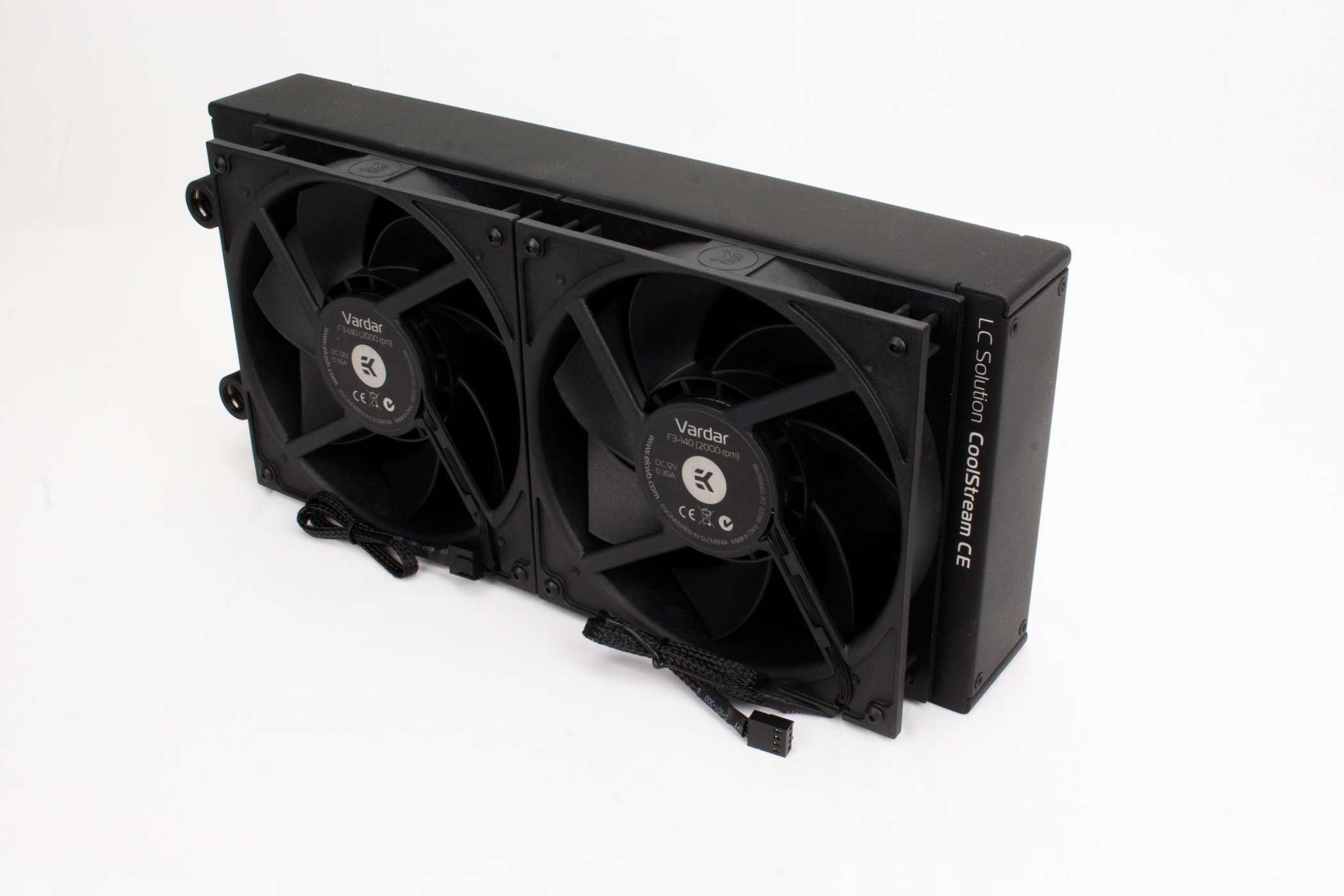
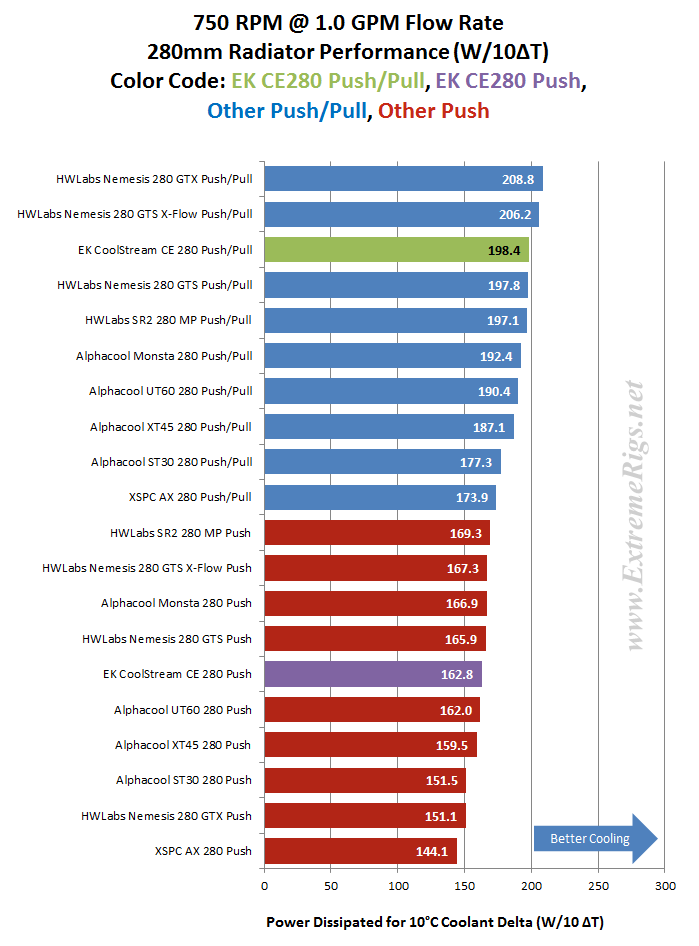
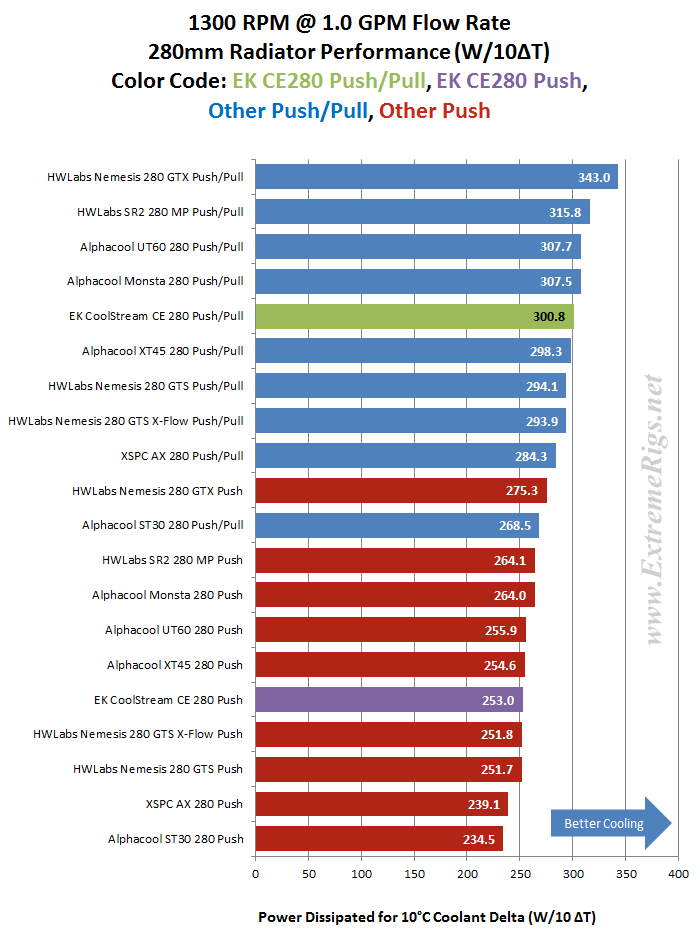
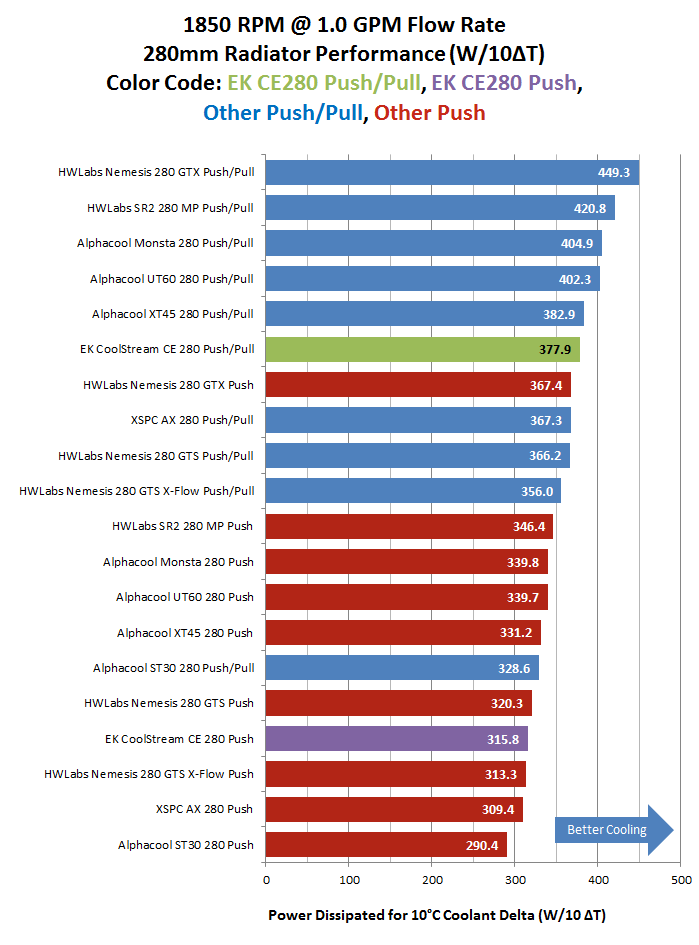
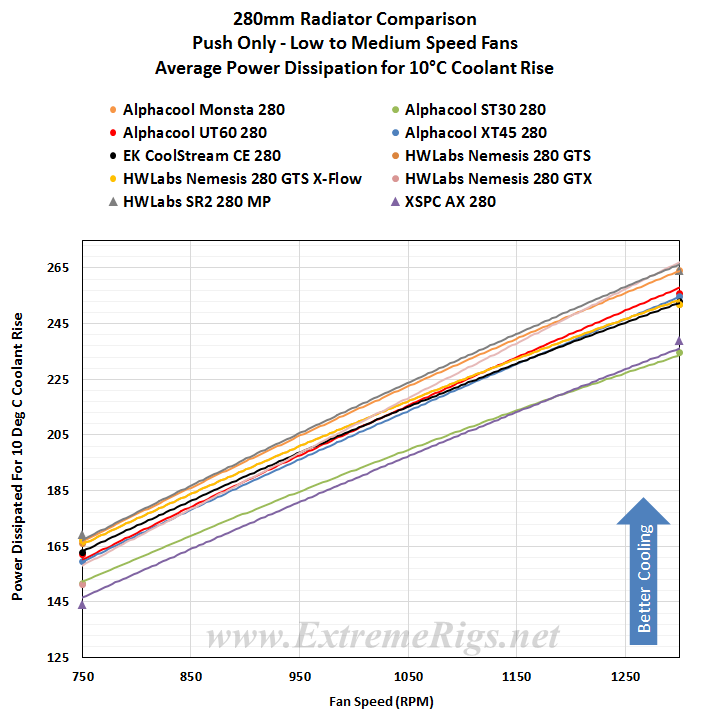
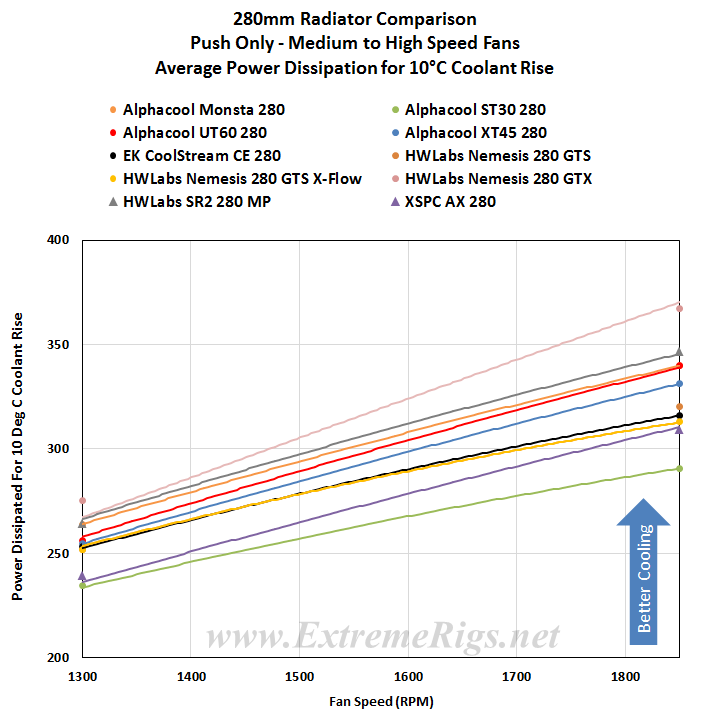
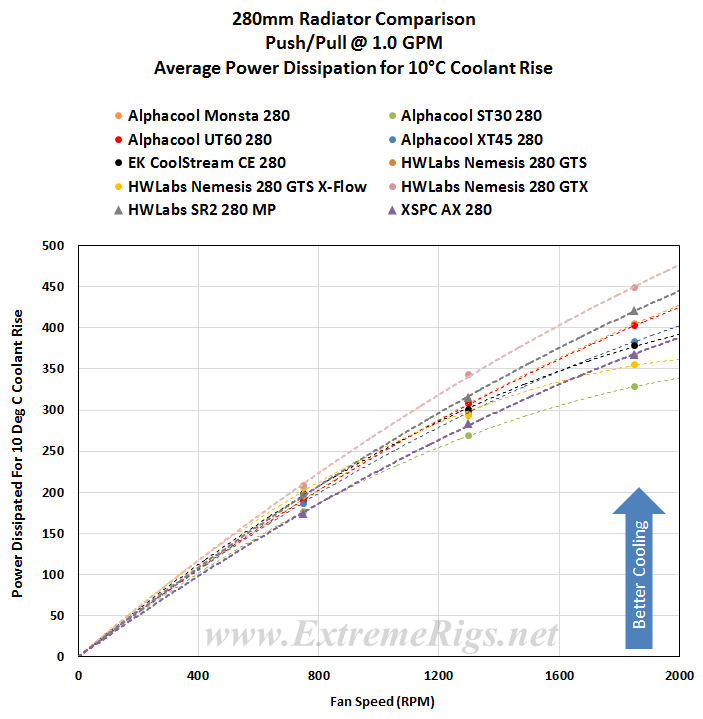
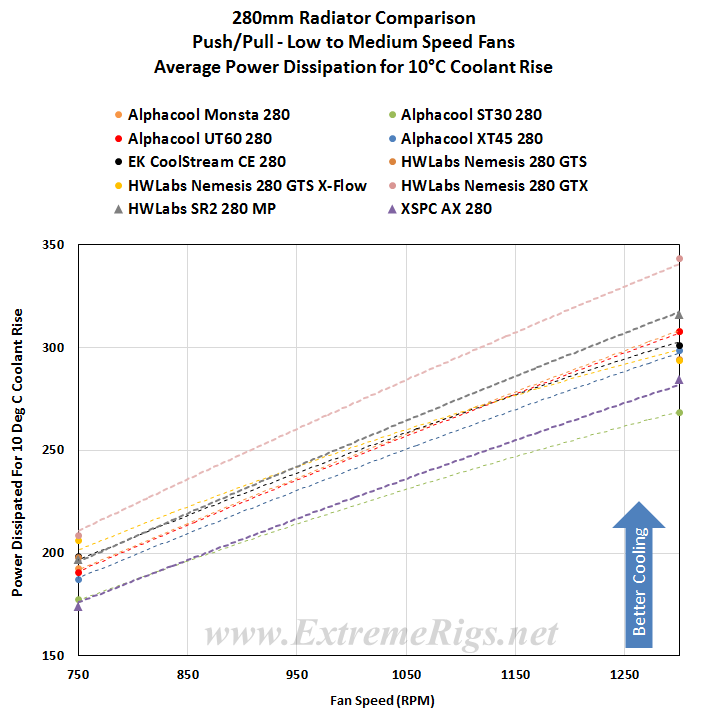
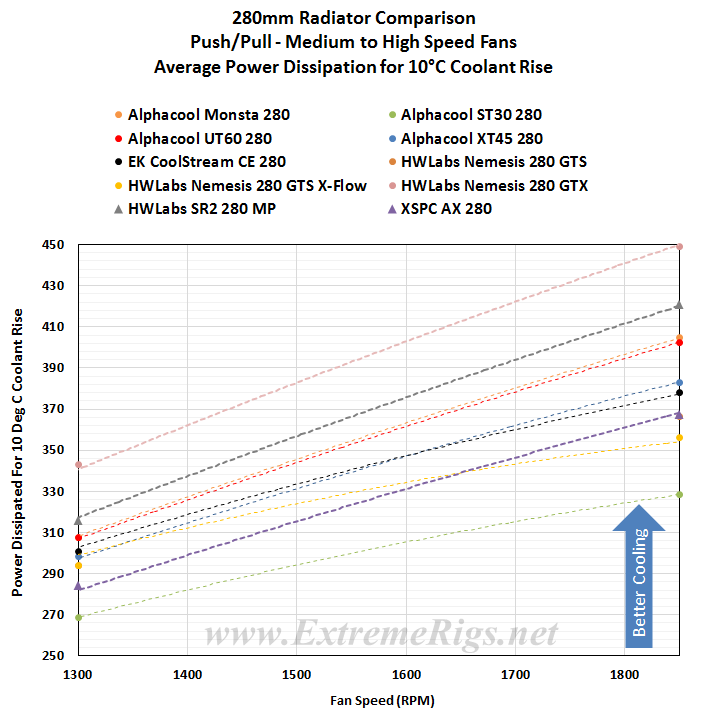
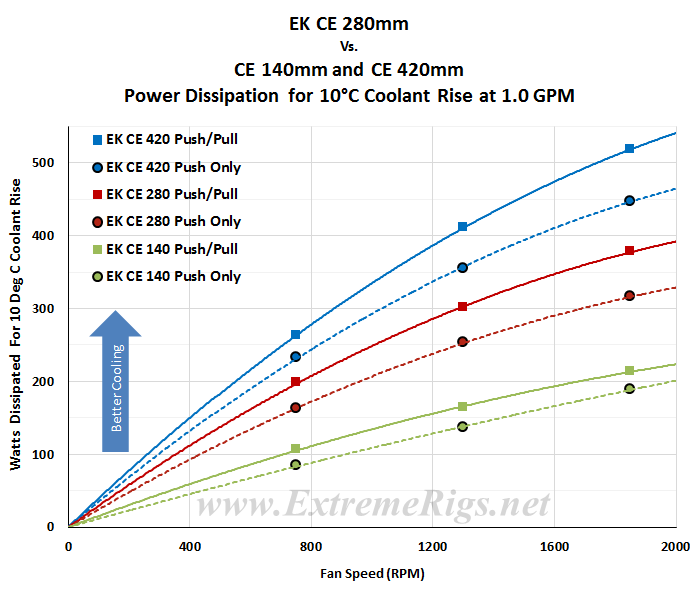
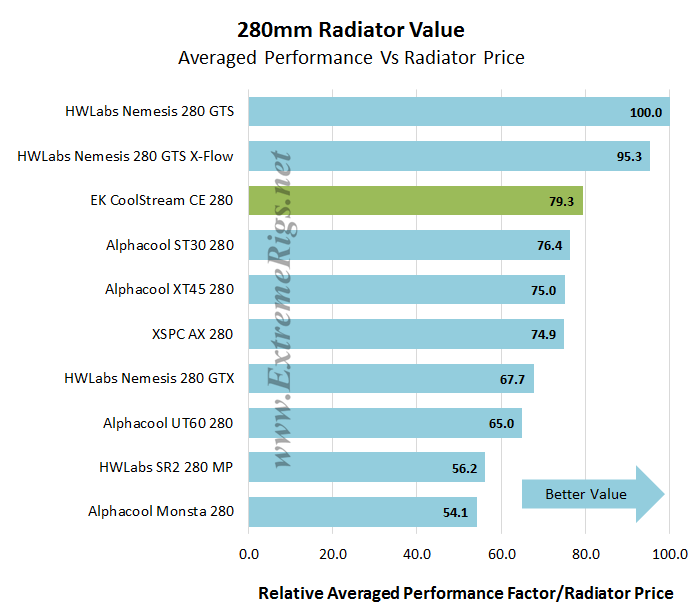




Your dear should specify the results in Celsius, Fahrenheit or Kelvin throughout your test. Because a conversion from Watts to the indicated temperatures is very inaccurate.
There is no formula with which you can convert from Watts in Celsius, Fahrenheit, or Kelvin, therefore your information is not meaningful and belong in a storybook
If you give me even a chemical or physics book shows where the formula is there, you would win the Nobel Prize. Other websites have soagr refuted your moronic calculation.
Thanks Steffen for your well researched and objective comment. All the plots are clearly labelled “Deg C” meaning degrees, celsius. So I’m not sure if you actually read the article or if you’re another keyboard jockey who wants to shit over other’s hard work because you have nothing better to do? As for our “moronic” calculation. Yes actually there is a calculation to generate power dissipation from temperature change within a liquid. If you know your flow rate, as we do, then you can use the specific heat capacity of the volume of water in question (the coolant in question) combined with the temperature change of the water to generate the energy cooled/second. Energy/Time is also know as Power (at least for steady state equilibrium as this is). So yes thank you for the offer but there is no need to award us a nobel prize for such basic physics, but maybe a bit of humble pie for you would be in order? Maybe even cite your sources next time as to why our calculation is so “moronic”?
Well, I found your reviews VERY helpful; in fact, I’m basing my purchase from info in your reviews…I need a dual fan (push only) radiator that’s 50 mm thin or thinner, that’s readily available (price don’t too much matter)…based on your reviews, and the needs listed above, I have decided on this EK Coolstream 280 CE (with the Alphacool XT45 coming in a close 2nd). I don’t have fans for it yet, because that’s depending on the rad being purchased (this rad is just being used as a secondary rad to the main Aquacomputer 480 rad I have).
Comments are closed.